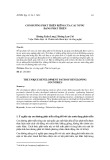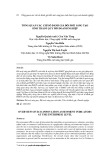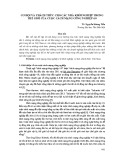
* Corresponding author
E-mail address:sajjadkhan_nice@yahoo.com (S.N. Khan)
© 2019 by the authors; licensee Growing Science, Canada
doi: 10.5267/j.uscm.2018.10.007
Uncertain Supply Chain Management 7 (2019) 179–190
Contents lists available at GrowingScience
Uncertain Supply Chain Management
homepage: www.GrowingScience.com/uscm
A study on the effect of supply chain management practices on organizational performance with the
mediating role of innovation in SMEs
Muhammad Khuram Khalila, Rashid Khalilb and Sajjad Nawaz Khanb*
aPhD Scholar, Faculty of Environmental Management, Prince of Songkla University, Thailand
bPhD. Scholar, Islamic Business School University Utara Malaysia
C H R O N I C L E A B S T R A C T
Article history:
Received September 9, 2018
Accepted October 12 2018
Available online
October 17 2018
This paper investigates the relationship between supply chain management practices and
organizational performance with the mediating role of innovation. Data were collected from 207
small and medium enterprises (SMEs) in Punjab, Pakistan. PLS-SEM was used to analyze the
proposed hypotheses. Findings reveal that strategic partnership with supplier and level of
information sharing had no influence on organizational performance. In addition, quality of
information sharing, internal supply chain process, and lean practices had significant influence
on organizational performance. Moreover, all five practices of supply chain management had
significant and positive influence on innovation. Meanwhile, innovation significantly and
positively mediated the relationship between supply chain management five practices and
organizational performance. The findings of this study will help managers of SMEs enhance their
performance.
ensee Growing Science, Canada
b
y the authors; lic9© 201
Keywords:
SCMP
Innovation
Organizational performance
1. Introduction
Supply chain management practices (SCMP) was gaining popularity in early 1990s when whole the
world was facing with massive competition in the world market in delivering goods and services at less
cost (Li et al., 2006). Some of the prior researchers reveal that business managers, academicians, and
consultants focus the concept of supply chain management (SCM) (Choon Tan et al., 2002; Croom et
al., 2000; Van Hoek, 1998). Various organizations think to recognize SCM in enhancing performance
of organizations (Jones, 1998). According to Li et al. (2006), SCM refers to unambiguously identifies
the tactical nature of harmonization among organization trading partners and also enlighten the twofold
objective of SCM: enhance individual organization performance and enhance whole organizational
performance (OP). The main challenge for organizations is learn what supply chain practices they
follow to enhance both organizational and operational performance. Many prior researchers have used
SCMP to improve OP (Azmi et al., 2018; Chavez et al., 2013; Gimenez et al., 2012; Liu et al., 2013;
Ramanathan, 2012; Sukati et al., 2012; Janaki et al., 2018). Other studies have inconclusive results and
need to study further SCMP and OP (Ketokivi & Schroeder, 2004; Pilkington & Fitzgerald, 2006) and

180
some other have examined the influence of practices on monetary performance only (Venkatraman &
Ramanujam, 1986). In the current study, we focus on both financial as well as non-financial
performance. SMEs plays an significant role in the developing of an economy (Wijetunge, 2017).
Nowadays, SMEs play a vital role in economic growth, poverty reduction, innovation, and employment
generation (Stokes et al., 2010). In developing countries especially, SMEs play a key role to contribute
rural economy, poverty reduction, employment creation, entrepreneurship development, exports
growth, and manufacturing industry (Stokes et al., 2010; Arora et al., 2017). Hence, SMEs are
considered critical and backbone for developing countries (Prasad, 2004). Prior studies have ignored
the mediating effect of innovation between SCMP and OP of SMEs. Hence, the current research is
trying to fill this gap.
2. Literature Review
2.1 Organizational performance (OP)
Organizational performance (OP) is referred to phenomena of how well enterprises obtain their desired
goals. There are various studies available in the past on OP but still, there is no universal definition that
can be used to measure OP. Some of the researchers use financial performance to measure OP. Some
others use non-financial performance to measure the performance of an organization. In the current
study, we are using financial and market factors to measure OP (Yamin et al., 1999).
2.2 Supply Chain Management Practices (SCMP)
According to Li et al. (2006), SCMP is referred to a combination of activities undertaken within the
organizations to encourage the efficient management of their supply chain. There are some researchers
that use various SCMP. For instance, continuous process flow, supplier partnership, cycle time density,
share information regarding technology, and outsourcing (Donlon, 1996). Choon Tan et al. (2002),
introduced 6 elements of SCMP; namely supply chain integration, customer service management,
information sharing, geographical propinquity, supply chain characteristics, and just-in-time capability.
Chen and Paulraj (2004), identified communication, supplier based reduction, cross-functional teams,
long-range association, and supplier involvement in measuring supplier and buyer relationship. Tan et
al. (1998) identified customer relationship, quality, and purchasing to represent SCMP. Hence,
literature depicts SCMP in terms of different perspectives but at the end one universal objective that is
to enhance OP.
2.2.1 Strategic partnership with suppliers (SPS)
SSP is referred to the long-range association with organizations and their suppliers (Li et al., 2006).
Some of the prior researchers elucidate that SPS is designed to leverage the operational as well as
strategic capabilities of employee participating corporations to facilitate them in attaining significant
onward advantages (Monczka et al., 1998; Noble, 1997; Stuart, 1997). Moreover, deliberate partnership
highlights direct, long-range relationship and promotes shared planning as well as efforts regarding
problem-solving (Gunasekaran et al., 2001). SPS allows organizations to function more efficiently with
more significant suppliers that are ready to divide responsibility for product success (Li et al., 2006).
Some of the prior studies revealed that SPS had a significant and positive influence on OP (Li et al.,
2006; Wijetunge, 2017). Moreover, SPS plays an important role in innovation and there is a study that
elucidated that SPS has a positive influence on innovation (Maalouf, 2018). The following hypotheses
are proposed for the current study:
H1: SPS has a positive influence on OP.
H2: SPS has a positive influence on innovation.
H12: Innovation significantly mediates the relationship between SPS and OP.

M. K. Khalil et al. / Uncertain Supply Chain Management 7 (2019)
181
2.2.2 Level of information sharing
Sharing of information consists of two elements such as quality and quantity; and both elements are
significant for supply chain management practices and they are used as exogenous constructs in prior
studies on supply chain management (Moberg et al., 2002; Monczka et al., 1998). Moreover, level of
information (quantity element) means to the extent to which vital and proprietary information are
transferred to organization supply chain partner (Monczka et al., 1998). Within an organization shared
information can differ from the strategic level to the tactical level as well as from logistics movements
to market and information related customers (Mentzer et al., 2000). Various researchers recommended
that information sharing with other parties in the supply chain could become a source for organizational
performance (Jones, 1998; Novack et al., 1995). Some of the prior studies elucidated that the LIS had
a positive influence on organizational performance (Li et al., 2006; Wijetunge, 2017). Meanwhile, the
level of information sharing has a positive influence on innovation (Didonet & Díaz, 2012). The
following hypotheses are proposed for the current study:
H3: LIS has a positive influence on OP.
H4: LIS has a positive influence on innovation.
H13: Innovation mediates significantly the relationship between a LIS and OP.
2.2.3 Quality of information sharing (QIS)
QIS consists timeliness, accuracy, credibility, adequacy, as final credibility of the information
communicated (Moberg et al., 2002; Monczka et al., 1998). Moreover, information sharing is
momentous, and the importance of its influence on supply chain management that what, when, and
with whom information is shared (Chizzo, 1998; Holmberg, 2000). Therefore, organizations need to
outlook their important information as organization asset and make sure that information
communicated with the least delay and distortion (Li et al., 2006). There is a positive influence of the
QIS on OP (Li et al., 2006). Moreover, the QIS is also important for innovation and authors elucidated
that it had a positive influence on innovation (Didonet & Díaz, 2012). The following hypotheses are
proposed for the current study:
H5: QIS has a positive influence on OP.
H6: QIS has a positive influence on innovation.
H14: Innovation mediates the relationship between the QIS and OP.
2.2.4 Internal supply chain process (ISCP)
ISCP also known as postponement is referred to the practice of going ahead one or more than one
operations such as making, sourcing, and delivering to a much afterward point in supply chain
management (Johnson & Davis, 1998; Naylor et al., 1999; Van Hoek et al., 1999). One of the authors
reveals that there is a need to develop postponement strategy such as examining how many steps
organizations want to postpone and which steps they want to postpone (Beamon, 1998). The benefit of
the postponement for organizations is that organizations have spare time changing the needs of
customer and modification of the demand function (Waller et al., 2000). ISCP has a positive influence
on organizational performance (Wijetunge, 2017). Moreover, the ISCP has a positive influence on
innovation (Didonet & Díaz, 2012). The following hypotheses are proposed for the current study:
H7: ISCP has a positive influence on OP.
H8: ISCP has a positive influence on innovation.
H15: Innovation significantly mediates the relationship between ISCP and OP.

182
2.2.5 Lean practice
Lean practice is referred to a process of eliminating waste time as well as resources in the production
process (Wijetunge, 2017). Moreover, a lean practice can be considered a value, an ethos, a philosophy,
a management concept, a work culture, and a methodology (Wilson & Roy, 2009). Nowadays, lean
practice means a management approaches that develop all the processes within the organization at every
level. According to Lewis (2000), the lean practice facilitates in removing all waste, stop shortages,
minimize lead time, enhance stock turnover, and make sure customer satisfaction. The lean practice
has a positive influence on organizational performance (Wijetunge, 2017). Moreover, the lean practice
has a positive influence on innovation (Maalouf, 2018). The following hypotheses are proposed for the
current study:
H9: The lean practice has a positive influence on OP.
H10: The lean practice has a positive influence on innovation.
H16: Innovation significantly mediates the relationship between lean practice and OP.
2.2.6 Innovation
The term innovation plays a significant character in enhancing the quality and performance of an
organization (Mone et al., 1998). It refers to the organizational efforts that give the advantage to the
organization in long-range (Maalouf, 2018). One of the prior studies reveals that organizations maintain
their strong positions in the existing market due to permanent investment in innovation and innovation
must be executed in business process as well as in technology (Pisano, 2015). Despite this, innovation
is an important element for enhancing organizational performance but various organizations fail to
perform well even due to innovation because they do not know exact guidelines that how to use that
technology and due to lack of formal rules and procedures (Maalouf, 2018). The following hypotheses
are proposed for the current study:
H11: Innovation has a positive influence on OP
Fig. 1. Theoretical Framework
3. Methodology
The theoretical model of this study consists of seven variables and all these variables are measured by
adapting the questionnaire from some of the prior studies since their reliability as well as validity had
Innovation Organizational
Performance
Supply Chain Management
Practices
Strategic Partnership
with Suppliers
Level of Information
Sharing
Quality of Information
Sharing
Internal Supply Chain
Process
Lean Practices

M. K. Khalil et al. / Uncertain Supply Chain Management 7 (2019)
183
been established. 5-Likert scales is used that has a range within 1 (strongly disagree) to 5 (strongly
agree). SCMP e.g. SPS consists of 5 items, LIS consists of 5 items, QIS consists of 5 items, ISCP
consists of 3 items, and lean practices consists of 3 items adapted from Li et al. (2006), innovation
consists of 5 items and adapted from Panayides and Lun (2009), and OP is adapted from Li et al. (2006).
4.1 Data collection
For current research, data were collected from SMEs that works in Punjab, Pakistan. 275 questionnaires
were distributed among owners of SMEs and only 217 questionnaires received back and 10
questionnaires exclude due to missing values. Hence, 207 were questionnaires used for the analysis.
4.2 Statistical analysis results
In this paper, we have employed a Partial Least Square (PLS-SEM) approach to examine the theoretical
model. Some of the prior researchers proved that PLS-SEM approach is suitable for both research
models such as simple and complex; also there is no need to perform normality test with subtleness
(Bamgbade et al., 2015; Hair Jr et al., 2014). In addition, this approach gives better results of estimation
to establish construct validities as compared to another approach such as CBC-SEM (Afthanorhan,
2013; Hair Jr et al., 2014). There is a need of two models in PLS-SME like measurement as well as
structural model. In the current study, we use both of these models.
4.3 Measurement model
According to Hair Jr et al. (2013), in the running measurement model in PLS tool we ascertain three
things. First, content validity, second, convergent validity, and the final one is discriminant validity.
4.3.1 Content Validity
Table 1
Factor loading and cross loadings
Variable Items SPS LIS QIS ISCP LP INV OP
Strategic partnership with suppliers SPS1
SPS2
SPS3
SPS4
SPS5
0.901
0.909
0.820
0.867
0.867
0.010
0.188
0.049
0.117
0.059
0.455
0.315
0.415
0.426
0.417
0.399
0.407
0.447
0.459
0.426
0.089
0.040
0.135
0.059
0.055
0.477
0.479
0.420
0.444
0.425
0.244
0.196
0.214
0.201
0.242
Level of information sharing LIS2
LIS3
LIS4
LIS5
0.104
0.090
0.082
0.057
0.904
0.872
0.820
0.881
0.071
0.101
0.091
0.112
0.135
0.114
0.044
0.141
0.039
0.009
0.026
0.048
0.236
0.223
0.168
0.253
0.112
0.053
0.025
0.102
Quality of information sharing QIS2
QIS3
QIS4
QIS5
0.428
0.312
0.145
0.238
0.044
0.069
0.116
0.037
0.729
0.752
0.690
0.720
0.184
0.196
0.192
0.189
0.281
0.333
0.022
0.212
0.227
0.361
0.452
0.314
0.214
0.180
0.561
0.157
Internal supply chain process ISCP1
ISCP2
ISCP3
0.110
0.202
0.450
0.062
0.030
0.200
0.457
0.446
0.453
0.826
0.876
0.807
0.007
0.018
0.367
0.336
0.376
0.796
0.475
0.486
0.306
Lean practices LP1
LP2
LP3
0.459
0.488
0.660
0.012
0.074
0.001
0.160
0.172
0.280
0.035
0.142
0.231
0.805
0.890
0.884
0.270
0.363
0.444
0.062
0.092
0.068
Innovation INV1
INV2
INV3
0.433
0.365
0.518
0.226
0.257
0.182
0.407
0.538
0.391
0.670
0.538
0.457
0.344
0.308
0.443
0.902
0.832
0.828
0.356
0.390
0.564
Organizational performance OP2
OP3
OP4
OP5
OP6
0.244
0.196
0.214
0.201
0.242
0.010
0.188
0.049
0.117
0.059
0.455
0.315
0.415
0.426
0.417
0.399
0.407
0.447
0.459
0.426
0.089
0.040
0.135
0.059
0.055
0.477
0.479
0.420
0.444
0.425
0.901
0.909
0.820
0.867
0.867
Some studies reveal that content validity is calculated by using cross-loading and it refers to that the
value of the measured variable should be higher than other study variables in the same rows as well as
columns (Chin, 1998b; Hair Jr, 2010) as shown in Table 1.










![Chiến lược cách mạng hóa công nghiệp [mới nhất]](https://cdn.tailieu.vn/images/document/thumbnail/2013/20130722/banhbeonhantom/135x160/1523609_066.jpg)






![Đề kiểm tra Quản trị logistics [mới nhất]](https://cdn.tailieu.vn/images/document/thumbnail/2025/20251015/2221002303@sv.ufm.edu.vn/135x160/35151760580355.jpg)
![Bộ câu hỏi thi vấn đáp Quản trị Logistics [năm hiện tại]](https://cdn.tailieu.vn/images/document/thumbnail/2025/20251014/baopn2005@gmail.com/135x160/40361760495274.jpg)







